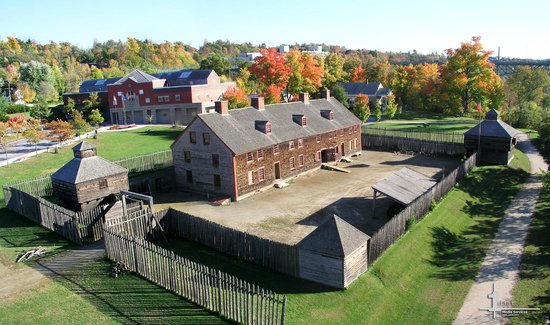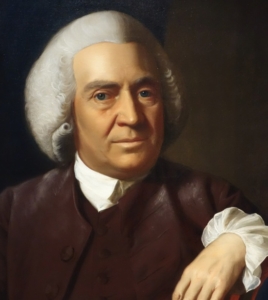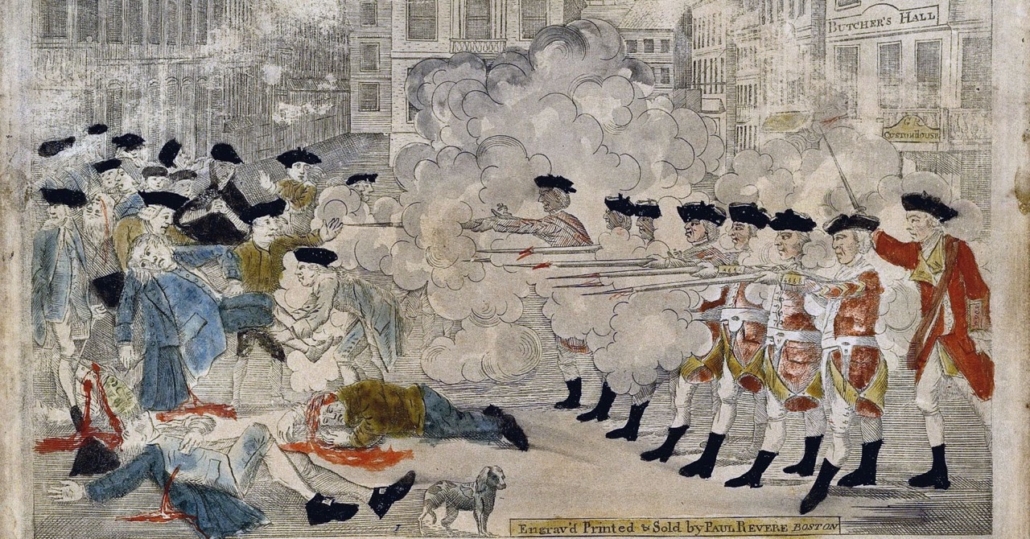Up and Down the Kennebec Valley: Augusta’s civic meeting houses
by Mary Grow
Enough, for now, of genealogies (although two boxes about people accompany this article). This week, your writer provides summary histories of more of Augusta’s 18th and 19th century public buildings.
Settled in the 1760s as part of Hallowell, Augusta became a separate town in 1797; became the shire town of Kennebec County in 1799 and the capital of the State Maine in 1827; and was incorporated as a city in 1849.
The first public building seems to have been a meeting house that served for civic and religious gatherings, its origin described in James North’s 1870 history of Augusta. (North used the name “meeting house” for buildings for civic gatherings and buildings for worship; quite often the same building served both purposes.)
Next came a series of courthouses – 1790, 1801-02 and 1829-30 – described in the April 3 issue in this series (related to the legal men who frequented them).
After the first courthouse, Henry Kingsbury said in his Kennebec County history, came the first jail, built in 1793 (Augusta jails will be the topic of a future article in this series).
* * * * * *
North named many early (1762-1771) settlers in the part of the Kennebec Valley that became Augusta, who got their land from the company known at different times as the Plymouth Proprietors, Plymouth Company, Kennebec Proprietors and by other names.
He said nothing about any public building except Fort Western (built in 1754 as part of British defense against the French) before Hallowell (then including Augusta) was incorporated in 1771.
Fort Western, on the east bank of the Kennebec, was the center of the settlement, which started there and expanded on both sides of the river. North described early town meetings at the fort in May and July 1771.
Voters at the May meeting raised money for roads and schooling, and told their selectmen to petition the Plymouth Proprietors to designate lots for a church and for “a meeting-house and burying place and training field.”
At a September, 1773, town meeting, voters approved building a meeting house, on the east bank of the Kennebec. The Revolution intervened, and North did not revert to the topic until the fall of 1777, when voters repeated the decision.
By then, according to Captain Charles Nash’s chapters on Augusta in Kingsbury’s history, the west side of the river was becoming as settled as the east. This time, North wrote, voters agreed to draw lots to decide which side of the Kennebec the meeting house should be on. The east side won, and voters created a committee to find a lot and assemble materials so the meeting house could go up on May 15, 1778.
West-side residents objected, and again the deadline slipped. In the spring of 1779, North wrote, after discussion at two consecutive meetings, voters finally decided to build the meeting house on the west side of the river, near what became Augusta’s Market Square – but not that year.
As best your writer can determine, Market Square was on the west bank of the Kennebec where Winthrop Street comes downhill and crosses Water Street, about in the middle of today’s Water Street business district.
Voters at a 1781 meeting voted to build the meeting house in 1782, chose a building committee and raised 150 pounds, payable “in lumber or the products of the land.” North wrote work started in 1782.
In one chapter he said the April 1783 annual town meeting was convened there and “immediately adjourned to Fort Western.” In another chapter, he said perhaps the first voters’ meeting there was on May 5, 1783.
The building was not finished immediately – floors, exterior and windows were left undone, and it could be used “only in warm weather.” In 1792, North wrote, three prominent men were chosen to plan finishing it; in 1793, money was raised by the sale of pews, and on Oct. 9, 1795, Henry Sewall (see box) wrote in his diary that he had helped plaster it.
A picture in North’s history shows a rectangular two-story wooden building (36-by-50-feet, North and Nash wrote), with a two-story porch that sheltered the entrance and contained stairs to the gallery.
By the spring of 1810, North wrote, town meetings had been moved to the courthouse, and the meeting house was abandoned and in disrepair. It stood partly in Winthrop Street, which had been laid out after the building was up.
In March 1810, the building was taken down and the materials sold to Lewis Hamlen, from whom “the town” bought them back and used them to build a new meeting house at the intersection of Winthrop and Elm streets, three blocks west of State Street.
This building was also two stories, North said, with town meetings held upstairs. The porch with stairs was on the back this time. The first town meeting there was a special meeting on Dec. 25, 1811.
(New England, with its Puritan heritage, did not generally observe Christmas until the latter half of the 19th century. It became an official United States holiday in 1870.)
The meeting house was used “for town meetings and school purposes” until 1848. By then, North wrote, it was “dilapidated,” and people thought the lot could be better used.
Efforts to rebuild or repair failed, and on April 10, 1848, voters told the selectmen to sell the building. North wrote that a man named Ai Staples bought it, for $105; moved it to a nearby lot; added 20 feet on the rear; and converted the second floor into a 50-by-60-foot hall with a 12-foot ceiling, named Winthrop Hall.
(Ai Staples [1806 -1880] was a Gorham native who moved to Augusta in 1838 with his wife, Ann Cascoline Merrill, and “worked in grocery, shipping and real estate businesses,” the Maine Memory Network says. Its website has a c. 1840 picture of him, donated by the Maine Historical Society.)
Augusta became a city in 1849, by legislative act, followed by local voters’ approval. A mayor, city council and other officials were chosen in the spring of 1850. An effort to go back to town government was defeated in July of 1853.
Wikipedia says the first city offices were in the Augusta Opera House, and “meetings were held in Winthrop Hall.” The hall was used for municipal and public gatherings of many sorts. In 1854, another 30 feet was added on the rear, making the space 50-by-90-feet, and the ceiling was raised to 20 feet.
The federal government took over Winthrop Hall in the fall of 1861 for a military hospital, North wrote. It was one of at least three in the city during the Civil War.
After the war, Winthrop Hall was again renovated and renamed Waverly Hall.
According to Wikipedia, the first Augusta City Hall, a two-story brick building on the east bank of the Kennebec at 1 Cony Street, on the north side of the street that crosses the river on the lower bridge, was built in 1895-96 and served until 1987. The second floor was used for public events (John Philip Sousa played there in 1897, Wikipedia says). The building is on the National Register of Historic Places, and is now an assisted living facility.
Augusta’s current city hall is also on the east side of the river, at 16 Cony Street, on the south side of the street near old Fort Western.
Henry Sewall
Henry Sewall was born October 24, 1752, in York, Maine, and spent his youth helping on his father’s farm and learning to be a mason like his father. He served in the Revolutionary army from May 1775 through the end of the war, and first came to Hallowell in September 1783.
After an unsuccessful business venture in New York, he returned to Hallowell around 1790. He soon became town clerk and held the post for 35 years, in Hallowell and then Augusta; was clerk of the Maine District Court from 1789 to 1818 and county register of deeds from 1799 to 1817; and rose to the rank of major-general in the state militia.
He also kept a diary, from which North drew information for his history.
The general married three times, on Feb. 9, 1786, to a cousin named Tabitha Sewall, on June 3, 1811, to another cousin, Rachel Crosby; and on Sept. 9, 1833 (shortly before his 81st birthday) to Elizabeth Lowell, from Boston. He and Tabitha had two sons and five daughters.
North told this story about General Sewall.
“When [the Marquis de] Lafayette, the nation’s guest, reached Portland in 1825, Gen. Sewall, who was well acquainted with him in the army, went on to see him, and warily approached in the crowd not intending at first to make himself known, but Lafayette saw and recognized him and perceiving his design exclaimed, ‘Ah! Henry Sewall you can’t cheat me.’ They embraced, and the aged soldiers wept.”
James W. North Jr.
James W. North, who wrote the book on which most of this week’s article is based, was born Feb. 12, 1810, in Clinton, according to WikiTree.
In his Augusta chapter in Kingsbury’s history, Capt. Charles E. Nash wrote of him, “Augusta never had a nobler citizen, nor one more loyal to its every interest, or who will be longer remembered, than James W. North.”
North’s parents died when he was two, Nash wrote. He provided no information on who took over the boy’s care, going on to his career: he studied at the Gardiner Lyceum (just downriver from Hallowell), read law with a Gardiner lawyer and was admitted to the bar in 1831. His first law office was in Augusta, in the fall of 1831; in the spring of 1832, he moved back to the part of Clinton that became Sebasticook in 1842 and Benton in 1850.
During 14 years there, he dammed the Sebasticook and used the water power for grist mills and sawmills, including “manufacturing lumber from his own timber lands.”
Then, Nash said, “his ancestral ties” brought him back to Augusta, where he owned “parcels of inherited land, that had originally belonged to his great-grandfather, Gershom Flagg.” Flagg (1705 – 1771) was a surveyor and one of the Plymouth proprietors.
On these lots, Nash said, North built North’s Block (your writer guesses a commercial building or buildings) and the 1856 Meonian building, using wood cut from his land in Benton, sawed at his mill on the Sebasticook and floated down to Augusta.
The Meonian Building stood between Fore and Water streets, six stories tall on Fore Street and four stories on Water Street. North said lower-floor stores and offices were topped by a two-story, 50-by-75-foor public hall 27 feet high, “with galleries hung on two sides and one end.”
The building’s name “is derived from Maeonia, a county of Asia Minor,” North wrote. He did not say why he chose it. (“County” is his word; on-line sources mostly say “region,” though some say “city” and one says Maeonia was briefly an independent kingdom. It was in Lydia, which is now part of Turkey.)
The 1856 building burned in Augusta’s downtown fire on Sept. 17, 1865, and was rebuilt in 1866, the same dimensions and with improvements, North wrote.
On another of his lots, he built Hotel North in 1877.
Augusta voters elected North to the legislature in 1849 and again in 1853, and he was Augusta’s mayor from 1857 through 1860. He was a “leading promoter” of gas lights, installed in Augusta in 1853, and “clerk and treasurer” of the city gas company until 1881, when his oldest son, Dr. James W. North, took over. The older North was also president of one Augusta bank and a director of another.
North died June 7, 1882. He and his wife, Phebe (Upton) (1810 – Sept. 11 or Sept. 13, 1876), whom he married Sept. 23, 1834, are buried in Augusta’s Forest grove cemetery, with all but the youngest of their four sons.
Main sources
Kingsbury, Henry D., ed., Illustrated History of Kennebec County Maine 1625-1892 (1892).
North, James W., The History of Augusta (1870).
Websites, miscellaneous.
Responsible journalism is hard work!
It is also expensive!
If you enjoy reading The Town Line and the good news we bring you each week, would you consider a donation to help us continue the work we’re doing?
The Town Line is a 501(c)(3) nonprofit private foundation, and all donations are tax deductible under the Internal Revenue Service code.
To help, please visit our online donation page or mail a check payable to The Town Line, PO Box 89, South China, ME 04358. Your contribution is appreciated!







Leave a Reply
Want to join the discussion?Feel free to contribute!